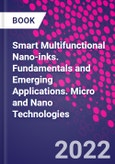Smart Multifunctional Nano-inks: Fundamentals and Emerging Applications covers nano-inks and how they can be used in inkjet printers for printing complex circuitry on flexible substrates or as a paste for 3D printers. Microstructures can be 3D-printed using nano-inks in a combination of high-resolution plasma printing and subsequent rotogravure printing. In addition, smart multifunctional nano-inks are not only required for the electronic, but also in other applications, such as for secure inks, for currency, and in immigration documents. This book focuses on fundamental design concepts, promising applications, and future challenges of nano-inks in various areas, such as optoelectronics, energy, security and biomedical fields.
The current challenge for the successful industrial application of nano-inks is in the preparation of a stable dispersion of advanced materials for nano-inks. The functionalization, synthesizing, and theoretical modeling provide the solution for most of the current issues, but there are still remaining challenges which are covered in this comprehensive resource.
Please Note: This is an On Demand product, delivery may take up to 11 working days after payment has been received.
Table of Contents
PART 1: BASIC PRINCIPLES1. Smart multifunctional nano-inks: An Introduction
2. Smart nanocontainers for smart nano-inks
3. Nano-inks: Synthesis and characterizations
4. Advanced 3D printers for smart multifunctional nano-inks
PART 2: NANO-INKS FOR ELECTRONIC INDUSTRIES
5. Graphene-based nano-inks for electronic industries
6. Nano-inks based on metal oxides for electronic industries
7. Polymer-based nano-inks for electronic industries
8. Nano-inks for optoelectronic applications
9. Nano-dots for electronic applications
PART 3: NANO-INKS FOR ENERGY GENERATION
10. Nano-inks for solar cells
11. Polymer-based nano-inks for solar cells
12. Nano-inks for fuel cells
13. Polymer-based nano-inks for fuel cells
14. Nano-dots for energy production
PART 4: NANO-INKS FOR ENERGY STORAGE
15. Nano-inks for batteries
16. Polymer-based nano-inks for batteries
17. Nano-inks for supercapacitors
18. Polymer-based nano-inks for supercapacitors
19. Polymer-based nano-inks for supercapacitors
20. MXenes for energy applications
PART 5: NANO-INKS FOR BIOMEDICAL APPLICATIONS
21. Nano-inks for drug delivery
22. Nano-inks for scaffolds
23. Nano-inks for tissue-engineering
24. Nano-inks for biosensors
PART 6: OTHER APPLICATIONS OF NANO-INKS
25. Nano-inks for sensors
26. Nano-inks in security and defense applications
27. Nano-inks for thermal protective applications
28. Nano-inks for packing industries
29. Nano-inks for EMI shielding application








